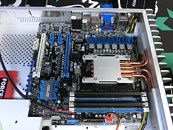Wednesday, October 3rd 2012

AMD Shows Off Silent A10-5700 System
AMD Japan teamed up with ASUS to display a concept 100% fanless (silent) HTPC build to buyers at Tokyo's Akihabara electronics shopping district. The build uses Streacom FC5 chassis with a CPU base modified for socket FM2. The base conducts heat from the processor using four copper heat pipes to the aluminum chassis, which doubles up as a heatsink. The build utilizes AMD A10-5700 APU, ASUS F2A85-M Pro micro-ATX motherboard based on AMD A85X chipset, 8 GB of AMD-certified DDR3-1866 MHz memory, and Corsair Force GT SSD. The concept build shows buyers that AMD's "Trinity" APUs are ready, willing, and able to power silent HTPC builds.
Sources:
FanlessTech, ITMedia.co.jp


40 Comments on AMD Shows Off Silent A10-5700 System
and there are pretty low TDPs. so yeah...
But personally I have had my HTPCs housed inside an isolated cabinet from IKEA for years, and a variety of builds ranging from my original e1200 celeron up to my current 2100T + HD 6400 (2gb/128-bit) and though I've added some ventilation for the sake of having weekend projects overall I've never had any real issues. Originally all I had was just a 120mm hole on the rear of the cabinet that I used for the wiring to the receiver and the only fan in the original build was on the e1200 (HD 5450 I had paired with that was passive).
So if you had sizable passive ventilation, I'd wager this would do just fine behind a glass cabinet door. Modern systems do quite well at throttling at idle and in sleep mode to cut down on heat compared to older systems. And use an SSD in here, and keep your media on a NAS somewhere to avoid mechanical storage dumping heat into there as well. The OS SSD in my server typically runs a solid 5-10c lower than the mechanical storage dumps, even the 1TB Raptor in my main rig runs between 33-38 vs 29-35 of my 240gb Kingston HyperX. So you can imagine the savings would be much greater in a case this size compared to a Corsair 600T that has a 240mm fan right in front of the hard drive rack.
But I really am anxious to get my hands on these new APUs for some HTPC builds, and see if I can shave some watts off my current system. 2100T + HD 6400 is pretty efficient, and I'm really disappointing AMD didn't release any 34/45w TDP parts, but I guess some later binning or undervolting/underclocking might get us there without any appreciable performance hit.
*edit*
Also, you'd wonder if they would release a heatsink adapter that would let you passively cool a GPU that you could hybrid crossfire with the IGP using the cooling fins on the other side of the case? AMD recommends using an HD 6670 with an A10 series APU, perhaps that could be passively cooled? Sapphire and HIS both have dual slot versions that are passive, but I guess you would have to share the CPU-side heatsink to get that same kind of surface area...
en.wikipedia.org/wiki/Heat_pipe. course in laptops heat pipes sit horizontally
My dream case back in the day :rolleyes: